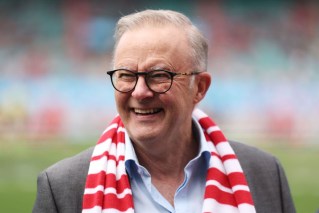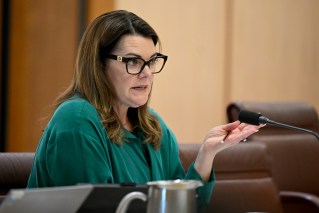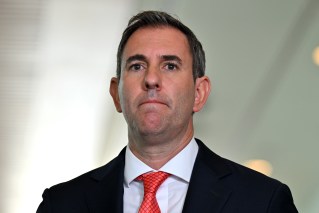Cost of living bites Scott Morrison as Labor gains in latest Roy Morgan poll

For the first time since the election campaign began, Labor has extended its election lead, as inflation worries and plunging confidence in government leave the Coalition on the wrong side of their own political divide.
This week’s exclusive Roy Morgan poll shows Labor has extended its already substantial election-winning lead by 1 percentage point to reach 55.5 to 44.5 per cent in two-party-preferred terms.
But the lift in support for the ALP after preferences does not reflect a gain in the party’s primary vote.
On voters’ nomination for first preferences, support for Labor remained flat on 35 per cent, drawing level with the Coalition, which dropped by 0.5 points relative to last week’s survey.
The Greens’ share of the vote increased slightly, in a partial recovery of the party’s drop in support last week’s poll with a 1 point rise to 13 per cent.
This shifts in support for the major parties ultimately tended to favour Labor when numbers were crunched on a two-party preferred basis.
“The ALP’s gain this week comes after two straight weeks of the LNP cutting into the ALP’s strong lead since the election was called just over three weeks ago,” Roy Morgan’s chief executive officer Michele Levine said.
“[But] both major parties continue to struggle to increase their primary votes.”
This week’s Roy Morgan poll interviewed 1487 Australian voters through a mix of telephone and internet survey across the week through until Sunday. The sample translates to a margin of error of 3 per cent.
Independents are the other beneficiaries from the reordering of support observed this week, the poll showed – a trend that will likely only add to speculation about the role of a cross bench in forming a possible post-election minority government.
The major parties’ tepid primary votes are unlikely to deter interest in possible constellations of post-election power sharing.
Nor is a second consecutive week in which electors’ declared support for independent candidates has surged by 1.5 percentage points.
The increase now has support for independent challengers at 9.5 per cent of the national vote, though it is the depth of this vote in a string of key seats that will prove decisive on election day. Some 7 per cent of voters did not declare a choice of party, a rise of 1 point.
State trends emerge
“The strong performance of independents in New South Wales and Victoria in this week’s Roy Morgan Poll bodes well for their chances of winning key Liberal seats,” Ms Levine said.

Only six months ago Scott Morrison tied his own political fortunes to the official cash rate.
But the headline measure of national support did not capture a reordering of the major parties’ support between states that could prove electorally decisive.
The Coalition kept its lead in Queensland (gaining 2 points to 56.5 to 43.5) and Western Australia (down 3.5 points to 51 to 49 per cent).
Labor, by contrast, grew its lead in New South Wales (up 1 point to to 56 to 44 per cent) and Victoria (growth of 3.5 points to 63.5 to 36.5 per cent).
“Although these results suggest that the LNP can hold onto most, if not all, of their seats in Queensland and WA that will not be enough to secure an election victory with the loss of seats in NSW and Victoria,” Ms Levine said.
Voters’ support for other minor parties fell.
One Nation’s recorded share of the primary vote dropped 1.5 points to reach 3 per cent. Support for Clive Palmer’s political vehicle also deflated by 0.5 points to 1 per cent.
Support for Other Parties, meanwhile, held steady at 0.5 per cent.
It has been well over a decade since the Reserve Bank last ordered a hike in interest rates.
But last Wednesday the issue returned to the centre of Australian politics with the release of new data showing annualised inflation rising at a rate of 5.1 per cent.
The higher-than-expected figure represents the highest rise in prices recorded in two decades, since the introduction of the Goods and Services Tax.
Inflation rises present the nation’s central bankers with a compelling case to raise interest rates when they meet on Tuesday.
Opinions differ on when the trigger might be pulled, but consensus seems to be growing that the Reserve Bank might order a rate hike as soon as today or early next month.
Interest rates’ return?
Such a decision would expose huge numbers of Australians to increase stress from mortgage repayments.
Senior figures in the Labor campaign believe that would undercut Prime Minister Scott Morrison’s claim to be the only leader Australians could trust to pilot the nation’s economy through its post-pandemic revival.
Mr Morrison, unusually, lost his cool on Monday when reporters tried to suggest the Prime Minister might pay a political price for any rate hike.
“It’s not about me,” Mr Morrison said in a testy response to a question on the campaign trail on Monday.
“It is not about politics. What happens tomorrow deals with what people pay on their mortgages.”
That answer obscures the fact that it was only six months ago that Mr Morrison expressly tied his political fortunes to the official cash rate in a fashion not unlike a Liberal hero, John Howard, who said interest rates would always be lower under a Coalition government.
In November, Mr Morrison came very close to matching his predecessor’s statement: “Australia’s economic recovery has to be secured by people who have a track record in economic management, otherwise you will see petrol prices go up, you will see electricity prices go up, you will see interest rates go up.”
If the bank lifts rates, Mr Morrison’s past statements will likely come into greater focus.
The results of Roy Morgan’s measure of confidence in government suggests that, even before a rate rise, voters are feeling pessimistic about where the economy might head next.
Exactly one half of voters surveyed now say that the government is headed in the wrong direction – growth of 3.5 points.
Only 34 per cent of those surveyed, a drop of 4.5 points, endorse the direction in which the nation is headed.
Roy Morgan’s broader government confidence rating is taken from the same sample as the weekly poll and is expressed as the difference between the proportion of people who say the country is headed in the right direction and those who do, plus 100.
The measure fell 8 points to 84, well below its neutral position of 100.
That leaves Roy Morgan’s measure of belief in government below average level in all six states but showing the greatest deficit in Queensland and NSW.








